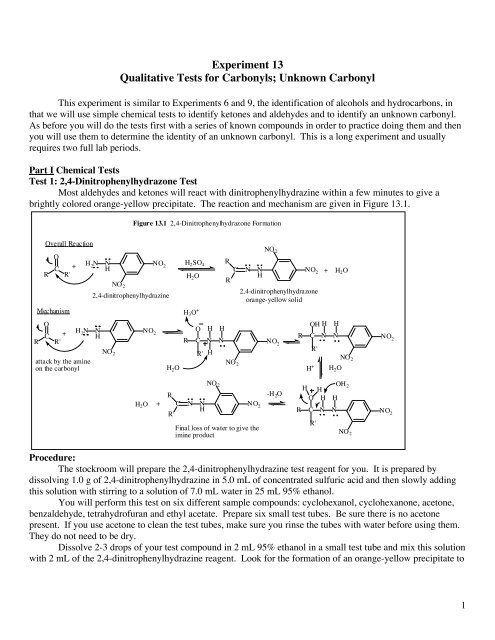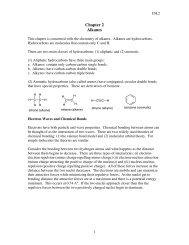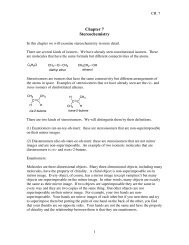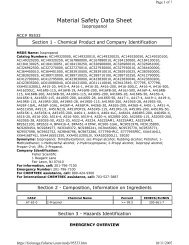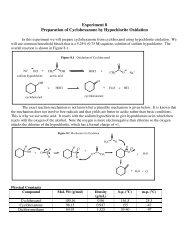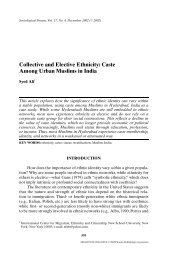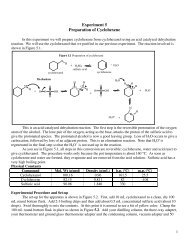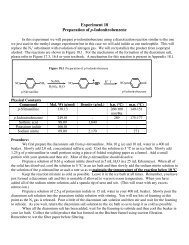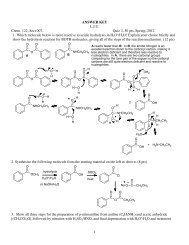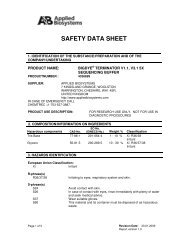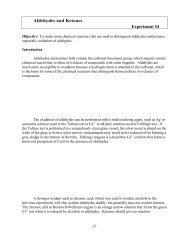Experiment 13 Qualitative Tests for Carbonyls; Unknown ... - myweb
Experiment 13 Qualitative Tests for Carbonyls; Unknown ... - myweb
Experiment 13 Qualitative Tests for Carbonyls; Unknown ... - myweb
Create successful ePaper yourself
Turn your PDF publications into a flip-book with our unique Google optimized e-Paper software.
<strong>Experiment</strong> <strong>13</strong><strong>Qualitative</strong> <strong>Tests</strong> <strong>for</strong> <strong>Carbonyls</strong>; <strong>Unknown</strong> CarbonylThis experiment is similar to <strong>Experiment</strong>s 6 and 9, the identification of alcohols and hydrocarbons, inthat we will use simple chemical tests to identify ketones and aldehydes and to identify an unknown carbonyl.As be<strong>for</strong>e you will do the tests first with a series of known compounds in order to practice doing them and thenyou will use them to determine the identity of an unknown carbonyl. This is a long experiment and usuallyrequires two full lab periods.Part I Chemical <strong>Tests</strong>Test 1: 2,4-Dinitrophenylhydrazone TestMost aldehydes and ketones will react with dinitrophenylhydrazine within a few minutes to give abrightly colored orange-yellow precipitate. The reaction and mechanism are given in Figure <strong>13</strong>.1.Figure <strong>13</strong>.1 2,4-Dinitrophenylhydrazone FormationOverall ReactionNO 2ORC H 2N N NOH2H 2 SO 4R+C N N NOR'H 2 OH 2 + H 2 OR'NO 22,4-dinitrophenylhydrazone2,4-dinitrophenylhydrazineorange-yellow solidMechanismH 3 O +OOH H HO H HRC +H 2N N NOH2R C N NNOR'R C N NNO 22NO 2HR'R'NOattack by the amineNO 22on the carbonylH 2 OH + H 2 ONO 2OHH2HR-H 2 OO H HH 2 O + C N N NOH2R C N NR'NO 2R'Final loss of water to give theimine productNO 2Procedure:The stockroom will prepare the 2,4-dinitrophenylhydrazine test reagent <strong>for</strong> you. It is prepared bydissolving 1.0 g of 2,4-dinitrophenylhydrazine in 5.0 mL of concentrated sulfuric acid and then slowly addingthis solution with stirring to a solution of 7.0 mL water in 25 mL 95% ethanol.You will per<strong>for</strong>m this test on six different sample compounds: cyclohexanol, cyclohexanone, acetone,benzaldehyde, tetrahydrofuran and ethyl acetate. Prepare six small test tubes. Be sure there is no acetonepresent. If you use acetone to clean the test tubes, make sure you rinse the tubes with water be<strong>for</strong>e using them.They do not need to be dry.Dissolve 2-3 drops of your test compound in 2 mL 95% ethanol in a small test tube and mix this solutionwith 2 mL of the 2,4-dinitrophenylhydrazine reagent. Look <strong>for</strong> the <strong>for</strong>mation of an orange-yellow precipitate to1
indicate the presence of an aldehyde or ketone. Record your results in your notebook. The color of the crystals,if any, is not indicative of an aldehyde or ketone but only that such a group is present.Test 2: Tollen’s TestThis test is selective <strong>for</strong> aldehydes. It is based on the fact that aldehydes can be oxidized to carboxylicacids while ketones can not. In the Tollen’s test, the aldehyde reduces Ag + , complexed with ammonia, to Ag 0(metallic silver) while it is oxidized to a carboxylic acid. Ketones do not undergo this reaction. When themetallic Ag 0 is produced it <strong>for</strong>ms a silver mirror on the inner side of the test tube. In order <strong>for</strong> the mirror to<strong>for</strong>m, the test tube must be very clean and without many scratches inside. The test tubes must be thoroughlyrinsed with water and soap. The reaction is shown in Figure <strong>13</strong>.2.Figure <strong>13</strong>.2 Silver(I) Oxidation of Aldehyes to Carboxylic AcidsORC Haldehyde++ 2 Ag(NH - 3 ) 2 OHH 2 OOR C O - ++NH 4+ 2 Ag 0 + NH - 4 OHcarboxylic acidsolid(ammonium salt)Procedure:We will do the Tollen’s test only twice, using a ketone <strong>for</strong> one test (either cyclohexanone or acetone)and an aldehyde <strong>for</strong> the other (use benzaldehyde).First prepare the Tollen’s reagent by adding 5 mL of 5% silver nitrate to 2 freshly cleaned medium sizedtest tubes. Add 3 drops of 10% sodium hydroxide to each test tube. Mix the solutions thoroughly. A browngrayprecipitate should <strong>for</strong>m. To each tube add 10% ammonium hydroxide solution drop-wise, shaking afterthe addition of each drop, until the precipitate just dissolves.Add 2-3 drops of ketone to one test tube and 2-3 drops of aldehyde to the other one. Shake the tubes tomix them and allow them to stand without shaking <strong>for</strong> 10 minutes. Look <strong>for</strong> the <strong>for</strong>mation of the silver mirror.Record your results in your notebook.Clean-up: To clean your tests tubes from the Tollen’s test you need to dissolve the silver in 20% nitricacid. This <strong>for</strong>ms water-soluble silver nitrate. Add a few mL of 20% nitric acid solution to the test tube whichcontains the silver mirror and, using your test tube brush, dissolve all the solid material.Test 3: Benedict’s TestThis test is similar to the Tollen’s test but it uses cupric salts (Cu 2+ ) as the oxidizing reagent. These arereduced to copper I salts (Cu + ) as the aldehyde is oxidized to a carboxylic acid. Again, ketones do not react.Benedict’s solution is made by dissolving copper sulfate, sodium citrate, and sodium carbonate together inwater. The Cu 2+ cation is solubilized by the citrate. When the copper is reduced to <strong>for</strong>m Cu + , it precipitates asbrick-red cuprous oxide.Procedure:Set-up six medium test tubes. We will do the Benedict’s test on cyclohexanol, cyclohexanone, acetone,benzaldehyde, tetrahydrofuran and ethyl acetate. Label the test tubes accordingly.Add 2 mL Benedict’s solution to each of the test tubes and then add 2-3 drops of test compound to eachtest tube. Heat the test tubes in boiling water <strong>for</strong> 10-15 minutes. Look <strong>for</strong> the <strong>for</strong>mation first of a pale greencolor followed by the <strong>for</strong>mation of the reddish precipitate of cuprous oxide. Record the results in yournotebook.2
Figure <strong>13</strong>.3 Copper (II) Oxidation of Aldehydes to Carboxylic AcidsORC HaldehydeO OH OO+ Cu 2+ - O C CH 2 C CH 2 C ONa sodium carbonate, H 2 OO CR C O - Na +O - carboxylic acid(sodium salt)blue copper-citrate complex+Cu 2Ored solidTest 4: Chromic Acid Test (also called Bordwell-Wellman Test)This test is similar to the Tollen’s test and the Benedict’s test in that it distinguishes aldehydes fromketones on the basis of their ease of oxidation. In the chromic acid test we use chromic acid to oxidizealdehydes to carboxylic acids; ketones do not react with chromic acid. Chromic acid is prepared by mixingchromium trioxide with dilute sulfuric acid. The orange Cr 6+ cation is reduced to the blue-green Cr 3+ ion.Figure <strong>13</strong>.4 Chromium (VI) Oxidation of Aldehyde to Carboxylic AcidORC Haldehyde+OH 2 Cr 2 OH 2 SO 4 7R C + CrOH2 (SO 4 ) 3orangecarboxylic acidblue-greenCr 6+ Cr 3+Procedure:Set-up six small test tubes in your test tube rack. We will test the same six compounds as in the 2,4-dinnitrophenylhydrazone and Benedict’s test (cyclohexanol, cyclohexanone, acetone, benzaldehyde,tetrahydrofuran and ethyl acetate). Add 1 mL of acetone to each tube and 2-3 drops of the test compound to thefirst test tube. Add 1 drop of the Chromic Acid reagent and shake vigorously using a small cork to stopper it.Record how long it takes <strong>for</strong> a color change (if any) to appear. Looking down the length of the upright testtube, resting on a white background, is the best way to judge color changes. Repeat with all of the testcompounds. Record the results in your notebook.Test 5: Schiff’s TestThe Schiff’s test is also used to discriminate between aldehydes and ketones. Aldehydes give a positivetest; ketones do not. Schiff’s reagent is made by adding the intensely colored triphenylmethane dye calledfuschsin to a solution of sodium bisulfite (NaHSO 3 ). The bisulfite reacts with the dye to produce a colorlesssolution. This colorless solution will then react with aldehydes – but not ketones – to produce a newtriphenylmethane dye that also has a brilliant purple color. This test is extremely sensitive and may give falsepositives. DO NOT RETURN USED REAGENT TO THE BOTTLE SINCE IT MAY BE CONTAMINATEDAND DO NOT TOUCH THE MEDICINE DROPPER OF THE REAGENT BOTTLE WITH YOURFINGERS. The reactions involved are shown in Figure <strong>13</strong>.5.3
Figure <strong>13</strong>.5 Schiff's Test with AldehydesHNOSOHNH 2H 2N + CHOOSHNHCOSOHfuschincolorlessbright purpleHNSOHNH 2NaHSO 3R C OOHOOHHNSCROHOH OHRCSNCHOHbright purpleOOHHNSCROHProcedure:We will do this test on two compounds, a ketone (negative test) and an aldehyde (positive test). Set uptwo test tubes and add 20 drops (~ 1 mL) of the Schiff’s Reagent to each test tube. Add 1 drop of the testcompound. Observe any color change. Record your results in your notebook.Test 6: Iodo<strong>for</strong>m TestThis test identifies the presence of a methyl ketone functional group. The reaction is shown in Figure<strong>13</strong>.6. In the basic reaction conditions, the proton that is next to the carbonyl (the α-proton) is removed. Thismakes the α-carbon into a nucleophile that attacks a molecule of iodine in the second step. The presence of oneiodine atom on the α-carbon increases the acidity of the remaining hydrogens. Each one is also removed by thebase to make a nucleophile that attacks more iodine molecules until all three hydrogens are replaced by iodine.The hydroxide ion attacks the carbonyl, which has made more electron deficient by the -CI 3 substituent. Withthe three electron withdrawing iodine atoms attached, the –CI 3 is a good leaving group. Finally, we produceHCI 3 , iodo<strong>for</strong>m, as a yellow solid that precipitates from solution.4
Figure <strong>13</strong>.6 Iodo<strong>for</strong>m ReactionROCCH 2H- OHROCCH 2I+ H 2 OIROCHCHI- OH+ I -ROCICHIIROC+IOHRO -CICOH IIOR C- OHICIIROCICHIIIROCHCII- OH+ I -ICIRCOO - +HCI 3Iodo<strong>for</strong>m -yellow solidProcedure:Dissolve 4 drops of a methyl ketone in 1 mL of methanol in a large test tube. Add 1.0 mL of a 10%NaOH solution. Then add KI/I 2 solution drop-wise with shaking until a slight excess of I 2 remains as indicatedby the yellowish or pale brown color of iodine.If 2 mL or more of the KI/I 2 reagent was used, then fill the test tube with water and allow it to stand <strong>for</strong>15 minutes. A yellow precipitate indicates a positive test.If less than 2 mL of the KI/I 2 reagent was used, then it may be necessary to heat the reaction <strong>for</strong> a shorttime (2-3 minutes) at 60 °C in a water bath. If all of the color disappears on heating, then add a few more dropsof the KI/I 2 reagent until the color persists. Fill the test tube with water and allow it to stand <strong>for</strong> 15 minutes. Ayellow precipitate indicates a positive test <strong>for</strong> a methyl ketone but a positive test is also produced byacetaldehyde, CH 3 CHO, and ethanol, which is oxidized by the I 2 to acetaldehyde.Part II Identification of Carbonyl <strong>Unknown</strong>:You will now identify a carbonyl unknown using the tests above and by preparing derivatives of yourunknown and taking the melting points. Your unknown will be one of those carbonyls listed in Table <strong>13</strong>.1 atthe end of this experiment. By comparing the melting points of your unknown derivatives to known valuesreported in the literature (see Table <strong>13</strong>.1) you can identify exactly your unknown compound. You can confirmthis identification by taking the IR and matching it with one of the spectra given in Appendix <strong>13</strong>.1.Procedure:Get a sample of an unknown aldehyde or ketone from the teaching assistant. Your first task is todetermine whether or not it is an aldehyde or a ketone. Per<strong>for</strong>m the Chromic Acid Test, the Tollen’s Test, andthe Iodo<strong>for</strong>m Test. Based on these results you should be able to determine whether your compound is one ofthe aldehydes or ketones and whether you have the methyl ketone [CH 3 C(O)] group.You will now prepare at least two derivatives of the unknown in order to determine its exact identity.Looking at the list in Table <strong>13</strong>.1 you see that there are three possible derivatives that you can use. Begin bypreparing the 2,4-dinitrophenylhydrazone and the semicarbazone. If, however, these two derivatives do notgive you a clear answer, then you will have to prepare the phenylhydrazone derivative. It is recommended thatyou prepare all three derivatives so as to give you extra in<strong>for</strong>mation in helping you make your finalidentification. But note from looking at Table <strong>13</strong>.1 you can see that some of the derivatives <strong>for</strong>m oils rather5
than solids with phenylhydrazone and so do not provide melting point data. You will ultimately be making youridentification on the basis of melting points and the purity of the sample that you use is critical in helping youobtain accurate melting points. Wet compounds do not melt at the expected range. In making your finaljudgment regarding the identity of the compound, remember that any and all mistakes made in taking meltingpoints give numbers that are too low. You can also determine the boiling point so as to help narrow yourchoices but it can be difficult to get an accurate boiling point.Preparation of SemicarbazonesDissolve 2.0 g of semicarbazide hydrochloride in 20 mL water. Add 3.0 g of crystalline sodium acetate.Mix and divide the reagent into two equal portions. Set aside one portion to use with your unknown. You willprepare one semi-carbazone using methyl ethyl ketone (2-butanone) <strong>for</strong> practice in order to learn the propertechnique and to see if you can obtain an accurate melting point and then you will prepare a semi-carbazoneusing your unknown.Add 0.5 mL (10 drops) of methyl ethyl ketone to one portion of the semicarbazide solution. Stopper thetest tube with a cork and shake vigorously. Filter the crystals using the Hirsch funnel and recrystallize fromethyl alcohol using the procedure described below. Be careful that you do not use too much ethanol since thesemi-carbazones are generally very soluble in ethanol. When the product is dry, determine its melting pointrange. If the melting point agrees with that given in Table <strong>13</strong>.1 then proceed to your unknown. Note that themelting point ranges actually obtained in the laboratory will invariable be lower than the values reported in theliterature due to impurities such as water and ethanol. The reactions involved are shown in figure <strong>13</strong>.7.Figure <strong>13</strong>.7 Semi-carbazone FormationOOOCl - + NH 3NHC NH+2Na + - OC HCH 2 O3NH 2NHC NH 2semicarbazidesodium acetateOORC O NH 2NH C RC+NH 2C N N NH 2 +HR'R'semicarbazoneH 2 ORecrystallization:Transfer the crystals to a small or medium test tube and add 1-2 mL of ethyl alcohol. The semicarbazonesare very soluble in ethanol so do not too much in the beginning. A good rule-of-thumb is to add justenough solvent to cover the crystals. Heat the mixture to boiling in a water bath using a hot plate.CAUTION! ETHYL ALCOHOL IS VERY FLAMMABLE. It is best to not use open flames whendoing a recrystallization from ethanol but if your test tube does catch fire do not panic. It burns with a gentleflame just like a candle. Simply cover the end of the test tube with your watch glass to extinguish the flame.If the product dissolves very readily in the initial volume of alcohol, it is best to boil off some of thealcohol. Then, add a few drops of water until a faint turbidity persists.If your compound does not dissolve in the initial amount of ethyl alcohol when heated to boiling, thenadd more ethyl alcohol a few drops at a time and reheat to boiling after each addition until the solution justbecomes clear. Note: you should work fairly quickly because your ethyl alcohol can all boil away if you leaveit in the boiling water bath. Once the solution becomes clear, add a few drops of water until a faint turbiditypersists.6
Cool the test tube, first to room temperature slowly, and then in an ice bath. Collect the crystals that<strong>for</strong>m by suction filtration using the Hirsch funnel. Wash the crystals with 1 mL of ice-cold ethyl alcohol anddry them as much as possible on a piece of filter paper. Transfer a small amount of the product to a piece offilter paper on a watch glass and complete the drying process by crushing the product on the paper. Determinethe melting point and record this in your notebook.Preparation of 2,4-DinitrophenylhydrazonesObtain 20 mL of the 2,4-dinitrophenylhydrazine reagent. Divide this into two equal portions. Save oneportion <strong>for</strong> your unknown. To one portion, add 0.5 mL (10 drops) of benzaldehyde. Shake vigorously to ensurethorough mixing. The 2,4-dinitrophenylhydrazone usually <strong>for</strong>ms immediately. If no precipitate <strong>for</strong>ms, set themixture aside <strong>for</strong> 15 minutes. Scratch the wall of the test tube occasionally with a glass stirring rod to helpinduce crystallization. If the crystalline slurry which <strong>for</strong>ms is too thick and heavy to filter easily, dilute it with10-15 mL water. Filter using the Hirsch funnel and recrystallize a portion of your material (a large spatula tip isenough) from ethyl alcohol using the procedure above as described <strong>for</strong> the semi-carbazone. Note, however, thatthe 2,4-dinitrophenylkhydrazone is much less soluble in ethanol than the semi-carbazone and you must use a lotmore ethanol. Note that the solubility will also depend on which unknown derivative you have made. Use amedium or large test tube. When the material is dry, determine the melting point. If the melting point agreeswith the literature value given in Table <strong>13</strong>.1 then proceed with your unknown. If not, make sure the hydrazoneis dry and pure. You may need to recrystallize them a second time.Preparation of Phenylhydrazones:First prepare a known phenylhydrazone using benzaldehyde to ensure the proper technique and thenrepeat the preparation using your unknown.Obtain 20 mL of phenylhydrazine-HCl reagent. Divide this into two 10 mL portions in two medium sizedtest tubes. Save one portion <strong>for</strong> your unknown. To the other portion, add 0.5 mL (10 drops) of benzaldehyde.Stopper the test tube with a cork and shake vigorously until the product crystallizes. Filter the crystals withsuction using your small Hirsch funnel. Wash the solid thoroughly with water. Recrystallize the product fromethyl alcohol using the procedure described above. If the melting point agrees with that given in Table <strong>13</strong>.1then proceed with your unknown.Procedure <strong>for</strong> Boiling Point DeterminationUse the set-up shown in Figure <strong>13</strong>.8 to determine the boiling point. You will need 2-3 mL of yourunknown. Place this in a 25 mL round bottom flask along with 2-3 boiling stones. Use the open ended Claisenadapter. Lower the thermometer so that it is just below the mouth of the round bottom flask. Heat the unknownliquid to boiling and continue heating until droplets of the liquid coat the thermometer and you reach a constanttemperature. Record this temperature. No vapors should escape but if you do smell vapors escaping, thenplace a condensing column in the open mouth of the Claisen adapter (not shown in the figure). You do not needto connect the water hoses <strong>for</strong> such a small volume. When you are done, you should allow the liquid to cooland then recover as much of the liquid as you can so that you have enough <strong>for</strong> the future tests. Determination ofthe boiling point will help you narrow down the possible choices <strong>for</strong> your unknown.7
Figure <strong>13</strong>.8thermometerground glassthermometer adaptor+ red rubber adaptorClaisen adaptorboiling chipsheating mantleplug to rheostatTable <strong>13</strong>.1Compoundb.p. (°C)Phenylhydrazone(m.p. °C)Semicarbazone(m.p. °C)2,4-Dinitrophenylhydrazone(m.p. °C)Propionaldehyde 48 oil 154, 89 155Acetone 56 42 187 1262-Butanone 80 oil 146 114n-Butyraldehyde 74 oil 106, 96 1233-Pentanone 102 oil <strong>13</strong>9 156Cyclopentanone <strong>13</strong>1 50 205 1422-Heptanone 151 oil 123 90n-Heptaldehyde 153 oil 109 108Cyclohexanone 156 77 166 1622-Furaldehyde 161 97 202 229, 2122-Octanone 173 oil 123 58Benzaldehyde 179 158 222 237Acetophenone 202 105 199 239p-Tolualdehyde 204 114 234, 215 234Note: Two melting values are given <strong>for</strong> some derivatives since they may occur in syn or anti geometricalisomers or in different polymorphic <strong>for</strong>ms.After you have identified your unknown and written the <strong>Unknown</strong> report, your instructor may be able totake the infrared spectrum to confirm your answer.8
Appendix <strong>13</strong>.1 Infrared Spectra of Carbonyl <strong>Unknown</strong>PropionaldehydeAcetone2-Butanone (Methyl Ethyl Ketone)n-Butyraldehyde9
3-Pentanone (Diethyl Ketone)Cyclopentanone10
2-Heptanonen-HeptaldehydeCyclohexanone2-Furaldehyde11
2-OctanoneBenzaldehyde12
Acetophenonep-Tolualdehyde<strong>13</strong>


